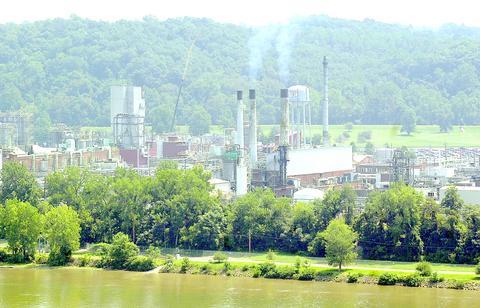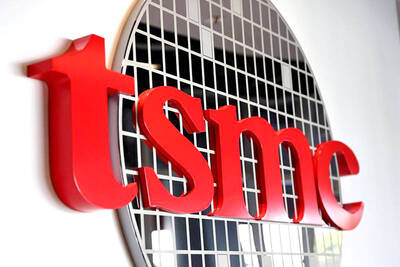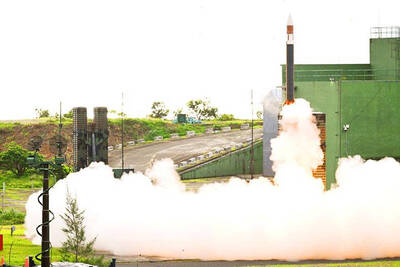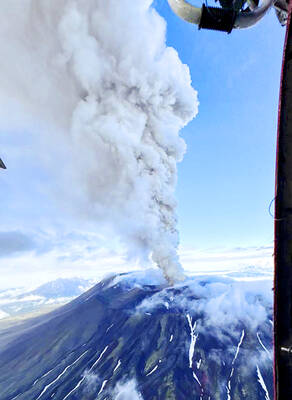Teflon has been hugely successful for DuPont, which over the last half-century has made the material almost ubiquitous, putting it not just on frying pans but also on carpets, fast-food packaging, clothing, eye-glasses and electrical wires -- even the fabric roofs covering football stadiums.
Now DuPont has to worry that Teflon and the materials used to make it have perhaps become a bit too ubiquitous. Teflon constituents have found their way into rivers, soil, wild animals and humans, according to company, government environmental officials and others. Evidence suggests that some of the materials, known to cause cancer and other problems in animals, may be making people sick.

PHOTO: NY TIMES
While it remains one of DuPont's most valuable assets, Teflon has also become a potentially huge liability. The Environmental Protection Agency filed a complaint last month charging the company with withholding evidence of its own health and environmental concerns about an important chemical used to manufacture Teflon. That would be a violation of federal environmental law, compounded by the possibility that DuPont covered up the evidence for two decades.
Formal response
DuPont contends that it met its legal reporting obligations, and said that it planned to file a formal response this week.
If an EPA administrative judge does not agree, the agency could fine the company up to US$25,000 a day from the time DuPont learned of potential problems with the chemical two decades ago until Jan. 30, 1997, when the agency's fines were raised, and US$27,500 a day since then. The total penalty could reach US$300 million.
The agency is also investigating whether the suspect chemical, a detergentlike substance called perfluorooctanoic acid, is harmful to human health, and how it has become so pervasive in the environment. The chemical -- which is more commonly known as PFOA or C-8, for the number of carbon atoms in its molecular structure -- has turned up in the blood of more than 90 percent of Americans, according to samples taken from blood banks by the 3M Co. beginning in the mid-1990s. Until it got out of the business in 2000, 3M was the biggest supplier of PFOA. DuPont promptly announced it would begin making the substance itself.
The EPA is auditing 3M to determine if there were any civil violations of environmental law involving its chemically related products, Cynthia Bergman, a spokeswoman for the agency, said. The EPA's action on July 8 prompted the Chinese government to begin its own study on the safety of Teflon, and some stores there pulled Teflon-coated pans from their shelves, the government-run China Daily newspaper reported.
Some people who live in or near Parkersburg, West Virginia, where DuPont has manufactured Teflon for 50 years, are not waiting for more studies. Thousands of them have joined in a class-action suit filed in Wood County Circuit Court against the chemical maker, which they charge knowingly contaminated the air, land and water around the plant for decades without informing the community. The chemical has been found in the public drinking water at levels exceeding a longtime internal guideline considered safe by DuPont. The trial is scheduled to begin next month.
DuPont is contesting the accusations, and insists that neither PFOA nor Teflon poses risks to humans. "The evidence from over 50 years of experience and extensive scientific studies supports our conclusion that PFOA does not harm human health or the environment," said Stacey Mobley, general counsel of DuPont, in a statement responding to the EPA ruling.
Critics say they will press their fight against the company because PFOA does not break down in the environment or in the human body, so the material that has been released could pose a health threat for many years. "This is an issue that won't go away for DuPont, because this chemical will not go away," said Jane Houlihan, vice president for research at the Environmental Working Group, an organization in Washington that is DuPont's most vocal critic.
Bigger problem
For that reason, some critics said they think that PFOA, and the family of perfluorochemicals known as PFCs to which it belongs, are potentially a bigger problem than many chemicals that have been banned.
That could have implications for hundreds of companies that use the materials, including the makers of popular brands like Gore-Tex, Stainmaster and SilverStone. "There's a huge ripple effect throughout the industry," says Rich Purdy, a toxicologist who was at 3M until 2000.
For DuPont, the controversy could hamper plans by its chairman and chief executive, Charles Holliday Jr., to shed the company's slow-growing businesses -- including the unit that makes nylon and Lycra, both of which it invented -- and focus instead on faster-growing businesses like genetically engineered seeds, soy-based products and electronics. While the company invests in those areas, it is banking on steady profits from products like Teflon.
Teflon-related products contribute at least US$100 million in profit annually, according to company reports and some court documents -- almost 10 percent of the company's 2003 total. DuPont has been pushing its Teflon-branded materials (known as fluoroproducts) for new uses -- like a built-in stain repellent for fabrics and a spray-on cleaning product -- and has identified new markets, including China, for expansion. The company has invested US$50 million to expand Teflon production and US$20 million on an advertising campaign in the US.
DuPont has reported revenue increases for both quarters of 2004, and earnings increased 57 percent in the first quarter of 2004. Frank Mitsch, an analyst with Fulcrum Global Partners, said he thought the EPA action would not have an immediate effect on DuPont. "This will be tied up in the courts for a while," he said.
Still, in announcing its second-quarter results on July 23, DuPont disclosed that it had set aside US$45 million as "a reserve for settlement in connection with the PFOA class-action suit." Gene Pisasale, an analyst with Wilmington Trust, a bank that was founded in 1903 by T. Coleman du Pont and is now one of DuPont's biggest shareholders, said that while "it's not a huge charge" -- the company spent more than US$1 billion on litigation over the fungicide Benlate -- "if this were to be a continuing thing, I would have to take a second look."
At the very least, the Teflon flap could damage DuPont's well-polished image. The 200-year-old company, based in Wilmington, Delaware, prides itself on its corporate values, and Holliday is a high-profile advocate of socially responsible business. "In the chemical industry, the critical thing is not only investor perception, but consumer trust," Pisasale said. "That can be very hard to build back."
In a preliminary risk assessment report released last spring, the EPA said PFOA was a possible carcinogen, but did not advise that consumers stop using Teflon products. PFOA is used as a processing aid in making many Teflon products and is not present in end products, like cookware. But some researchers assert that some Teflon products can release PFCs, including PFOA, in the environment and in the human body. They contend that this could account for its wide presence in the environment and in the population.
A spokesman for W.L. Gore & Associates, which makes Gore-Tex, said the material it gets from DuPont does not break down into PFOA, but he conceded that the material could contain trace amounts and that there was still an open question about safety. "Are the downstream folks involved? Sure. We all want to find the sources and pathways here," the spokesman, Ed Schneider, said.
Human exposure
A study that appeared this month in Environmental Science & Technology, published by the American Chemical Society, found varying levels of PFCs, including PFOA, in the blood of people living on four continents. The researchers postulated that prolonged use of products containing PFCs -- like paper products, packaging, carpet treatments and stain-resistant textiles and cleaners -- could be a major source of human exposure.
DuPont dismisses such reports as speculation, and says it is working with the EPA to study the sources of PFOA in the environment. Because PFCs do not occur naturally, the most likely sources are thought to be manufacturing releases or breakdown from products. The company acknowledges that fumes from Teflon pans subjected to high heat can release gasses unrelated to PFOA, which can kill pet birds and cause a flulike condition in humans known as polymer fume fever. PFOA is known to cause cancer in some animals, and has been linked to liver damage and other problems in animals. Its effects on human health have been little studied.
In the 1980s, a DuPont study of female workers exposed to the substance found that two out of seven women gave birth to babies with facial defects similar to those observed in the offspring of rats that had been exposed to PFOA in another study. In its complaint, the EPA charged that DuPont had also detected PFOA in the blood of at least one of the fetuses and in public drinking water in communities near DuPont plants, but did not report that it had done the tests.
There is no federal requirement for companies to test unregulated chemicals like PFOA, but if companies have reason to believe a substance poses a threat, they are required by the Toxic Substances Control Act to notify the EPA. The agency also said DuPont was in violation of another federal environmental law for not providing all of the toxicological data it had gathered about the chemical after a 1997 request from the agency.
Revelations
The class-action lawsuit, filed in Wood County, the home of the Washington Works plant where DuPont has made Teflon for decades, has turned up a series of documents that DuPont had sought to shield as proprietary information. The latest came to light in May, when the West Virginia Supreme Court voted unanimously to unseal several DuPont memorandums from 2000 in which John Bowman, a company lawyer, warned two of his superiors -- Thomas Sager, a vice president and assistant general counsel, and Martha Rees, an associate general counsel -- that the company would "spend millions to defend these lawsuits and have the additional threat of punitive damages hanging over our head."
He added that other companies that had polluted drinking water supplies near their factories had warned him that it was cheaper and easier to replace those supplies and settle claims than to try to fight them in court. And those companies, he noted, had spilled chemicals that did not persist in the environment the way that PFOA does. "Our story is not a good one," he wrote in one memorandum. "We continue to increase our emissions into the river despite internal commitments to reduce or eliminate the release of this chemical into the community and environment because of our concern about the biopersistence of this chemical."
Another document summarizes the company's strategy for deflecting the PFOA issue and litigation. It offers various suggestions for improving credibility with employees, the community and regulators, like "keep issue out of press as much as possible" and "do not create impression that DuPont did harm to the environment."
Local officials said the memorandums -- with the EPA's action and recent tests that found increasing PFOA levels in their water -- confirmed their fears.
"We've been exposed since at least 1984," said Robert Griffin, general manager of the Little Hocking Water Association, which serves about 4,000 homes in rural Washington County, Ohio, directly across the Ohio River from DuPont's Washington Works plant. "The community could have dealt with it back then, but DuPont saw fit not to inform us."
In June, Griffin included a warning in his annual water quality report to customers. It stated, in bold capital letters, that until the issue was resolved, "You are drinking this water at your own risk."

Authorities have detained three former Taiwan Semiconductor Manufacturing Co (TMSC, 台積電) employees on suspicion of compromising classified technology used in making 2-nanometer chips, the Taiwan High Prosecutors’ Office said yesterday. Prosecutors are holding a former TSMC engineer surnamed Chen (陳) and two recently sacked TSMC engineers, including one person surnamed Wu (吳) in detention with restricted communication, following an investigation launched on July 25, a statement said. The announcement came a day after Nikkei Asia reported on the technology theft in an exclusive story, saying TSMC had fired two workers for contravening data rules on advanced chipmaking technology. Two-nanometer wafers are the most

NEW GEAR: On top of the new Tien Kung IV air defense missiles, the military is expected to place orders for a new combat vehicle next year for delivery in 2028 Mass production of Tien Kung IV (Sky Bow IV) missiles is expected to start next year, with plans to order 122 pods, the Ministry of National Defense’s (MND) latest list of regulated military material showed. The document said that the armed forces would obtain 46 pods of the air defense missiles next year and 76 pods the year after that. The Tien Kung IV is designed to intercept cruise missiles and ballistic missiles to an altitude of 70km, compared with the 60km maximum altitude achieved by the Missile Segment Enhancement variant of PAC-3 systems. A defense source said yesterday that the number of

A bipartisan group of US representatives have introduced a draft US-Taiwan Defense Innovation Partnership bill, aimed at accelerating defense technology collaboration between Taiwan and the US in response to ongoing aggression by the Chinese Communist Party (CCP). The bill was introduced by US representatives Zach Nunn and Jill Tokuda, with US House Select Committee on the Chinese Communist Party Chairman John Moolenaar and US Representative Ashley Hinson joining as original cosponsors, a news release issued by Tokuda’s office on Thursday said. The draft bill “directs the US Department of Defense to work directly with Taiwan’s Ministry of National Defense through their respective

Tsunami waves were possible in three areas of Kamchatka in Russia’s Far East, the Russian Ministry for Emergency Services said yesterday after a magnitude 7.0 earthquake hit the nearby Kuril Islands. “The expected wave heights are low, but you must still move away from the shore,” the ministry said on the Telegram messaging app, after the latest seismic activity in the area. However, the Pacific Tsunami Warning System in Hawaii said there was no tsunami warning after the quake. The Russian tsunami alert was later canceled. Overnight, the Krasheninnikov volcano in Kamchatka erupted for the first time in 600 years, Russia’s RIA